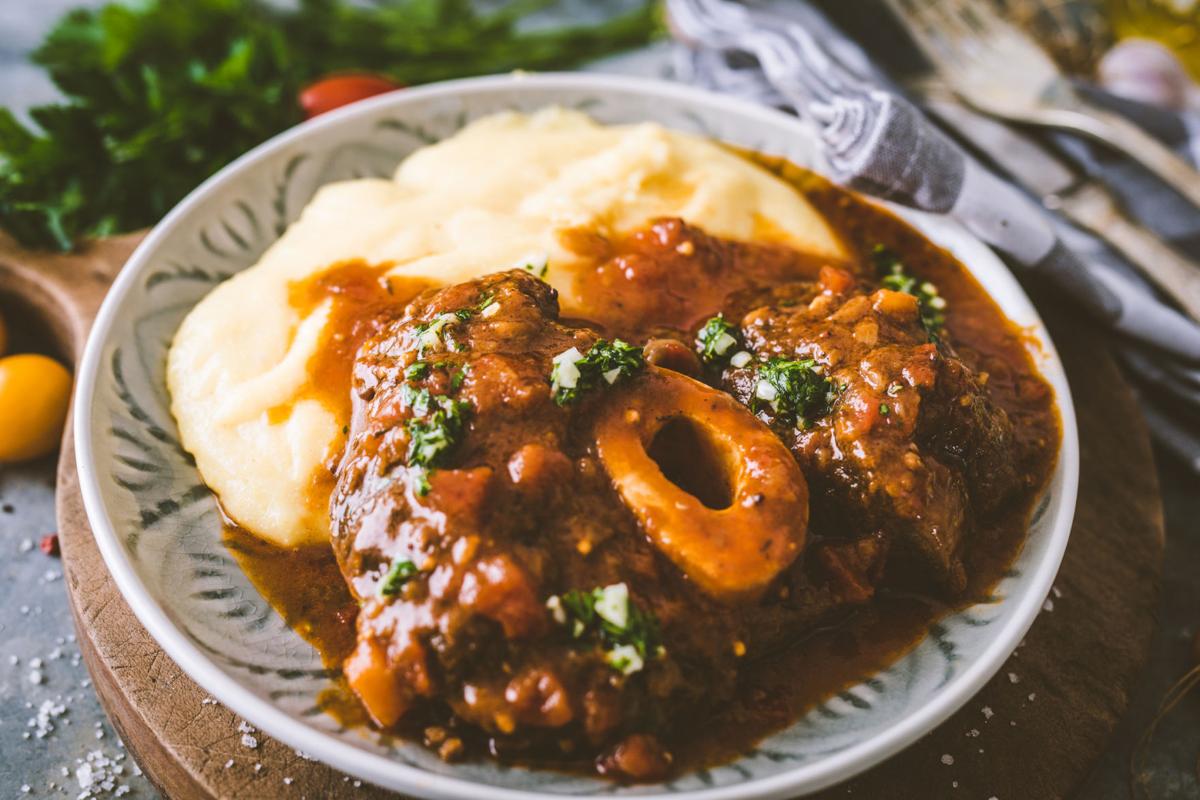Regular readers of this column know that Iтm especially fond of the odd cuts т less expensive cuts of beef, pork and chicken that often use low-and-slow cooking methods to tenderize them and extract their flavor fully.
Whether your goal is to stretch your food budget or simply to dine well, the cross-cut beef shanks I use in this recipe will help you reach both goals simultaneously. The shanks were on sale at one of my grocers this week, and they were a bargain for sure. But with this recipe on hand, youтll always know at least one good thing to prepare with them whenever you see them.
Beef shanks come from the portion of the leg just below the cowтs shoulder. Because the muscles they include are heavily used as the cow walks, theyтre far too tough to sear, grill or broil like a ribeye or strip steak.
But, as is true for me, a long, hot bath softens their outlook and improves their temper. After a leisurely braise, the beef shanks become completely tender and full of flavor.
People are also reading…
Today, Iтm providing you with a recipe thatтs a mash-up of two of my favorites. Beef carbonnade, the Belgian dish of beef and onions braised in dark beer, typically uses chuck roast т another tougher cut that wants to be braised т cut into slices rather than cubes. Itтs mighty good on a chilly evening.
Osso bucco, the classic braise of veal shanks from Milan, is usually garnished with gremolata т that lively, pungent blend of parsley, garlic and lemon zest minced together т and served over a saffron-tinted risotto. Itтs fragrant and colorful, so pleasing to the nose and eye on gray days.
For todayтs recipe, I adopted the dark beer from the carbonnade but cooked my beef shanks like osso bucco. I did so because I happened to have a single bottle of Barrio Breweryтs amazing Nolanтs Porter stashed way in the back of the fridge. If youтre not quite that fortunate, any dark beer т stout, porter or dark ale т will do. Lagers and pilsners are just too wimpy to contribute much, so if thatтs all you have, replace the 12-ounce bottle of beer with another cup and a half of beef stock, or with the same measure of dry red wine.
When my mother made shanks т beef or veal т she took the meat from the bones and put it back into the pot. She served the braised bones separately, with clever little spoons to extract the rich marrow to eat on its own or to spread on toast тsoldiers.т
I donтt have her clever spoons, however, so I usually serve the shanks as they come out of the braising liquid. Itтs a much more rustic way to serve the shanks.
Iтm also more likely to have the fixins for mashed potatoes or polenta handy than I am to have what I need to make a spendy saffron risotto. Either makes a good-if-humble base for the braise.
BEEF SHANKS AND ONIONS BRAISED IN DARK BEER
Makes about 6 servings
For casual service, leave the shanks whole so each diner can dig out their succulent marrow for himself. For more elegant service, shred the meat from the bones and stir the marrow into the stew before serving or serve the bones on the side.
INGREDIENTS
4 pounds cross-cut beef shanks
Coarse salt and freshly ground black pepper
1 tablespoon olive oil
2 large onions, sliced into half moons
2 tablespoons tomato paste
12 ounces dark beer, such as Barrio Brewingтs Nolanтs Porter
1 28-ounce can diced tomatoes
10 cloves garlic, thinly sliced
1 sprig fresh rosemary
3 cups beef stock
Cooked polenta or mashed potatoes, for serving
Chopped parsley, for garnish
PREPARATION
Preheat the oven to 325 degrees F.
Season the beef shanks with salt and pepper. Heat the oil in a Dutch oven over medium-high heat.
Brown the shanks, in batches if necessary, until golden brown on both sides, about three minutes per side. Transfer to a plate. Reduce the heat to medium, add the onions to the pot and cook, stirring, until just starting to soften, about three minutes. Add the tomato paste and cook, stirring, one minute. Add the beer, bring to a boil, scraping up the browned bits, and simmer until reduced by about half.
Add the tomatoes, garlic, rosemary and one-half teaspoon salt, then return the shanks to the pot. Nestle the shanks into the tomatoes, then add the stock (it should almost cover the shanks). Bring to a simmer. Cover the pot, transfer to the oven and braise until the meat is very tender, about three hours.
Use a ladle to remove as much of the fat from the surface of the cooking liquid as possible. Season with salt and pepper and serve with the cooked polenta or mashed potatoes. The bones can be served on the side if desired; the marrow is delicious spread on toast.
Robin Mather is a longtime food journalist and the author of “The Feast Nearby.” Follow her blog as she writes her third book, “The Feast of the Dove,” at .
















